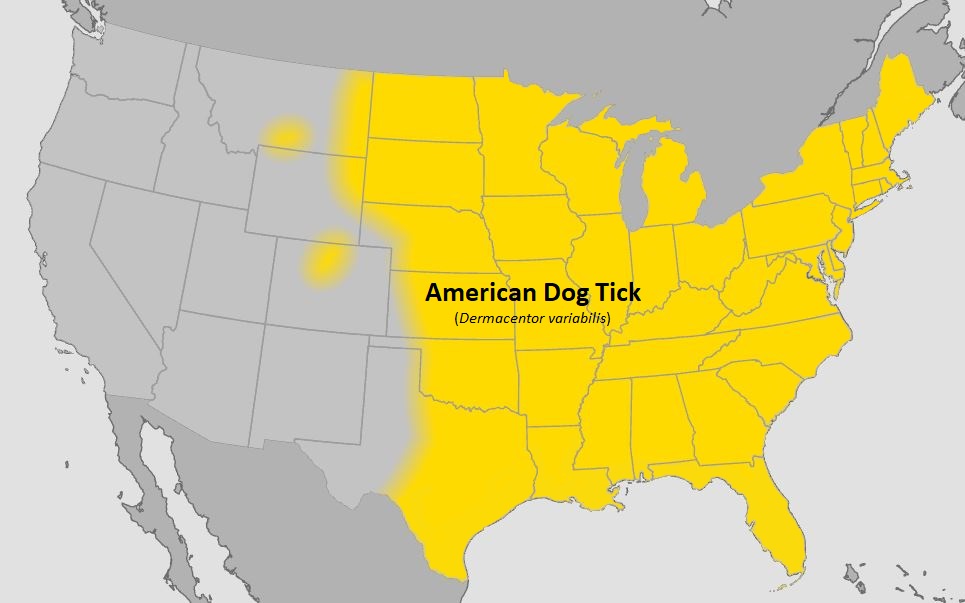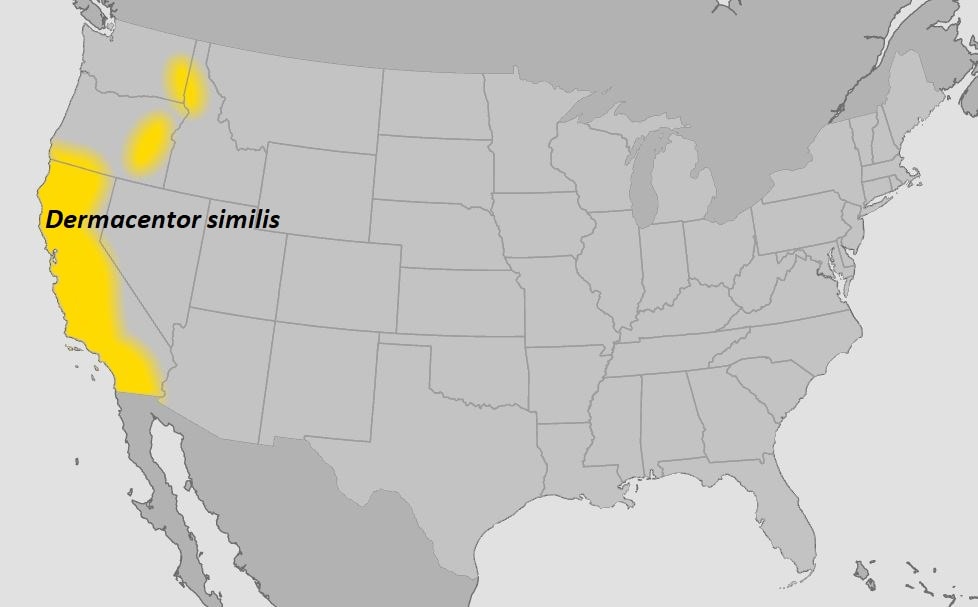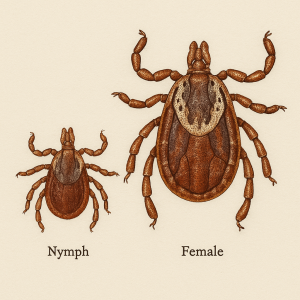Description & Other Names
The American dog tick (scientific name Dermacentor variabilis) is sometimes just called a “wood tick” or “dog tick.” It’s one of the larger hard ticks in the U.S. Adult females are maybe about 5 mm unfed (like the size of a small watermelon seed), and can engorge to the size of a grape when full. These ticks are ornate – meaning they have pretty markings on their backs. The females are brown with an off-white or silver-gray patterned shield (scutum) behind the head. Males are smaller and have mottled brown and gray/white markings over their whole back. They have brown legs. Overall, they appear brown with whitish streaks or spots on their backs. Dog ticks are hardier-looking than deer ticks, with short, strong mouthparts. They’re called dog ticks because they commonly bite dogs (if you have a dog that goes outside, you might have seen these on them).
Where Found
American dog ticks are widely distributed east of the Rocky Mountains. They are common in the Eastern U.S. and Midwest. They’re also found in some parts of the West Coast (patchy areas of California, etc.). Essentially, draw a line at the Rockies. Almost everywhere to the right (east) has dog ticks. They like grassy fields, brush along roads and trails, and tend to be more common in open areas with tall grass rather than deep woods. They’re very common in the Central and Eastern states, including places like Pennsylvania, the Carolinas, Georgia, the Great Lakes region, Kansas, etc. If you go for a walk in an overgrown field or sit on grass in these areas in spring/summer, dog ticks might latch on. Unlike deer ticks that love forest leaf litter, dog ticks love open, sunny areas with grass. You should think of meadows, unmanaged lawns, and clearings.


Diseases Spread
American dog ticks are the primary transmitters of Rocky Mountain Spotted Fever (RMSF) in the eastern U.S. They carry Rickettsia rickettsii, the RMSF bacterium, and are responsible for a lot of those cases, especially in the hot spot states (NC, OK, etc.). They can also transmit Tularemia (Rabbit fever). In fact, tularemia got the nickname “rabbit fever” because dog ticks (and lone star ticks) would transmit it from rabbits to people. Tularemia is not super common, but it pops up in Missouri, Arkansas, Oklahoma, and parts of the Martha’s Vineyard (strange hotspot in MA for rabbit fever). Dog ticks do not transmit Lyme or anaplasmosis (different tick family).
Active Season
Spring and early summer are the peak times for American dog ticks. They are most active during the late spring/early summer months (April through July) in many areas. By mid-summer, in hot areas, they can become less active as it gets very hot and dry. They prefer warmer weather though, so in cooler northern states, they can be found throughout summer. Adult dog ticks (which are the stage that most often bites humans) have a peak in May-June. They tend to quest up to knee-high on grass and latch on as you walk by. They also commonly bite dogs, so dogs can bring them into yards or homes. Because they’re larger, they’re often easier to spot crawling on you before they attach (compared to tiny deer ticks).
How to Identify
American dog ticks are larger and have ornate white/silver markings. If you see a tick with a patterned shield (some say it looks like white paint or marbling on the back), it’s likely a Dermacentor tick (either American dog tick or a related species). In the East, that’s the American dog tick. The female has a white to off-white shield near the head and a brown body; the male is speckled all over with white and brown. No other Eastern tick has that ornamentation except the Gulf Coast tick (which has a somewhat similar look, but usually more confined to the Gulf states) and the Rocky Mountain wood tick out West. Also, size: dog ticks are noticeably bigger than deer ticks or Lone Stars. After feeding, female dog ticks become huge gray blobs (often found on dogs under collars or in hair). Another ID tip: dog ticks have relatively short mouthparts and a rectangular-shaped head when viewed from above, whereas ticks like Lone Star and deer ticks have longer mouthparts. But that’s hard to notice without a magnifier. Honestly, the color pattern is easiest. If it’s got a ornate scutum with white/silver and you’re in the East, you’ve got a dog tick. If you’re in the Rockies, it could be a wood tick (they look quite similar, just different region). Dog ticks are often the ones that people find crawling on their clothes after a hike in a field. They also can survive a while in a house (but they don’t infest homes the way soft ticks or brown dog ticks can).


